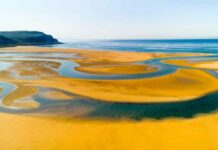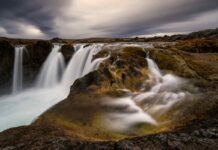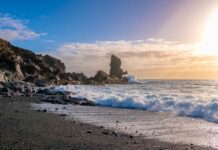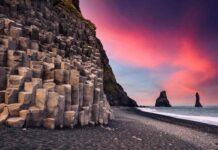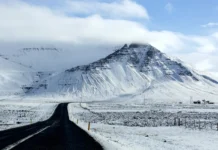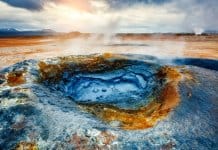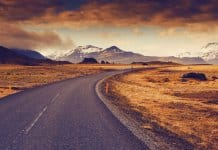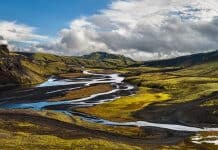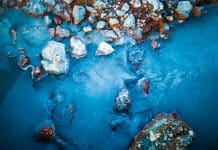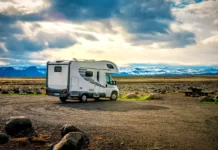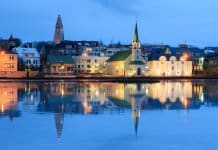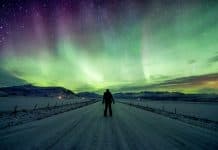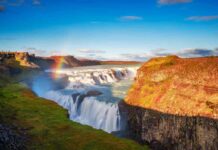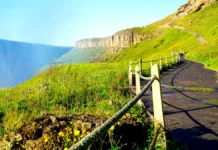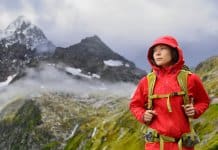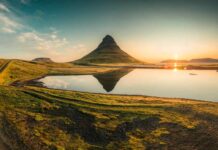Iceland, known as the “Land of Fire and Ice,” is home to some of the most breathtaking natural landscapes on Earth. One of its most mesmerizing features is the abundance of waterfalls in Iceland. With over 10,000 waterfalls scattered across the country, these natural wonders are a highlight for any traveler. Whether you’re embarking on a road trip or camping adventure, Iceland waterfalls are sure to leave you in awe with their sheer beauty and power.
This guide will take you through the best waterfalls in Iceland, offering tips on how to visit, what to expect, and why each one is worth adding to your itinerary. If you’re planning a trip to Iceland, make sure to pack your camera and prepare to experience the majesty of these incredible waterfalls. 
Why Iceland is Famous for Its Waterfalls
Due to its unique geology, Iceland is rich in both glaciers and volcanic activity, which creates the perfect conditions for waterfalls to form. Many of the famous waterfalls in Iceland are fed by glacial meltwater, while others flow through deep canyons carved by volcanic eruptions. What makes Iceland’s waterfalls so special is the sheer variety—from massive, thunderous falls to tranquil, hidden cascades nestled within Iceland’s lush valleys.
How Many Waterfalls Are in Iceland?
While it’s impossible to pinpoint the exact number, estimates suggest that Iceland has over 10,000 waterfalls. The country’s wet climate, coupled with the presence of glaciers and mountains, means that new waterfalls can form regularly, particularly after heavy rainfall or during the glacier melt in spring.
Top Iceland Waterfalls You Must Visit
1. Gullfoss: The Golden Waterfall
Gullfoss, meaning “Golden Falls,” is arguably the most famous waterfall in Iceland. Located along the popular Golden Circle route, Gullfoss cascades in two dramatic stages into the Hvítá River canyon. The sheer power and size of this waterfall are mesmerizing, with the water plunging 32 meters into the canyon below.
The best time to visit Gullfoss is during the summer when the surrounding landscape is lush and green, providing a striking contrast to the white, foamy water. However, it’s also spectacular in the winter, when the falls are surrounded by snow and ice, creating a magical frozen scene.

2. Seljalandsfoss: The Walk-Behind Waterfall
One of the most iconic waterfalls in Iceland, Seljalandsfoss offers a unique experience. Visitors can walk behind the waterfall, providing a one-of-a-kind view through the cascading water. This 60-meter-tall waterfall is located just off the Ring Road, making it a convenient stop for travelers exploring the southern coast of Iceland.
Be prepared to get a little wet as you walk behind the waterfall, especially if there’s a breeze. Bring waterproof clothing and proper footwear to safely navigate the slippery paths. Seljalandsfoss is particularly beautiful at sunset, as the golden light illuminates the falls and the surrounding landscape.

3. Skógafoss: A South Iceland Gem
Skógafoss is another must-see waterfall in Iceland, located not far from Seljalandsfoss along the southern coast. This powerful waterfall plunges 60 meters and is one of the largest in Iceland, with a width of 25 meters. On sunny days, Skógafoss often creates stunning rainbows in the mist, adding to its magical appeal.
A staircase next to the waterfall allows visitors to climb to the top for an impressive view of the surrounding area. The base of the waterfall is also a popular spot for camping, with nearby campgrounds offering great amenities. If you’re planning to camp in the area, be sure to check the campground map of Iceland for the best locations.

4. Dettifoss: Europe’s Most Powerful Waterfall
Located in the remote north of Iceland, Dettifoss is the most powerful waterfall in Europe. It is fed by the Jökulsá á Fjöllum river, which originates from the Vatnajökull glacier, Iceland’s largest ice cap. The sheer force of Dettifoss is overwhelming, with the water thundering over the edge at a height of 44 meters and stretching 100 meters across.
Visiting Dettifoss requires a bit more effort, as it’s located in the Vatnajökull National Park, a rugged and remote region. However, the dramatic landscape and the incredible power of the waterfall make it well worth the trip. Be sure to bring proper hiking gear if you plan to explore the surrounding area.

5. Svartifoss: The Black Falls
Svartifoss, located in Skaftafell within Vatnajökull National Park, is known for its striking basalt column backdrop. These hexagonal columns were formed by volcanic activity and provide a stunning contrast to the white waterfall. Svartifoss, which means “Black Falls,” is relatively small compared to some of Iceland’s other waterfalls, with a drop of 20 meters. However, its unique beauty makes it one of the best waterfalls in Iceland.
The hike to Svartifoss is around 1.5 kilometers from the visitor center and takes about 45 minutes. Along the way, you’ll pass several smaller waterfalls, and the trail offers beautiful views of the surrounding landscape.
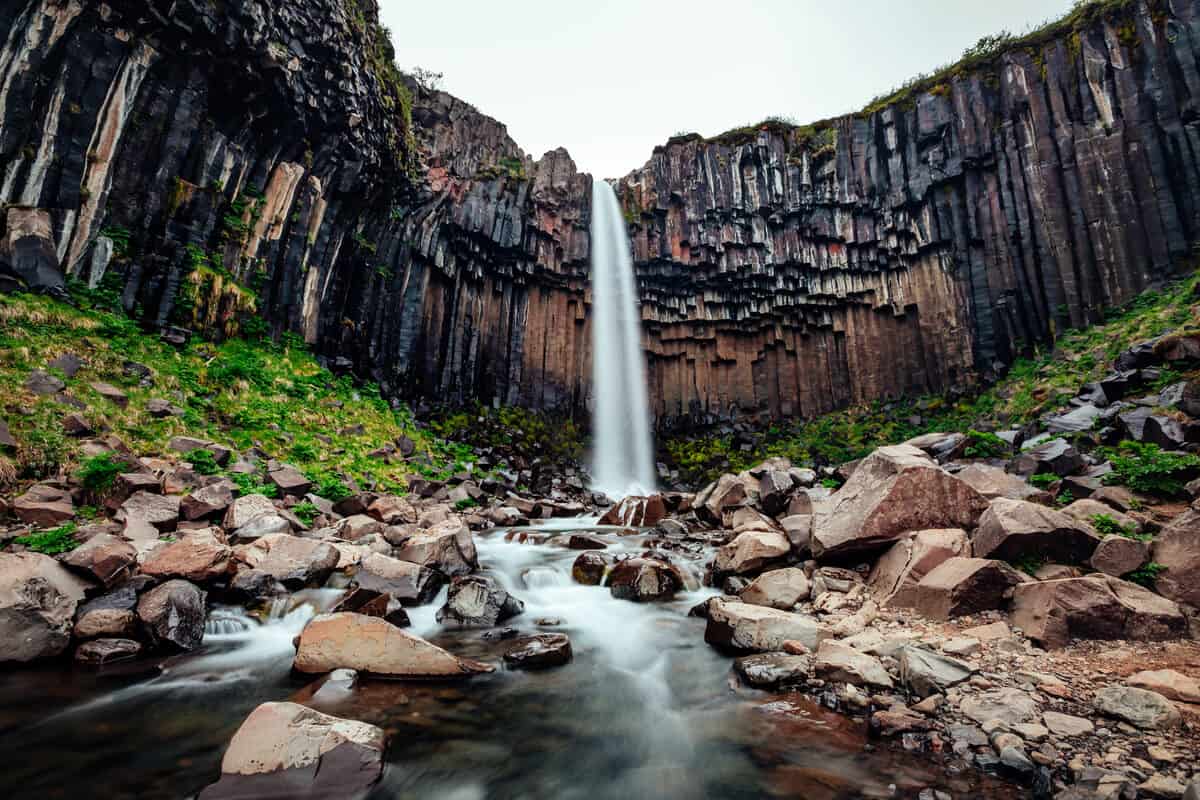
6. Goðafoss: The Waterfall of the Gods
Goðafoss, located in the northern part of Iceland, is steeped in history and legend. According to Icelandic sagas, Goðafoss was the site where pagan idols were thrown into the water when Iceland converted to Christianity in the year 1000. The name “Waterfall of the Gods” reflects this historical event.
Goðafoss is 12 meters high and 30 meters wide, making it a relatively small but incredibly picturesque waterfall. Its horseshoe shape and vibrant blue water make it a favorite among photographers. Goðafoss is easily accessible from the Ring Road and is a great stop for those exploring the north of Iceland.

7. Dynjandi: The Jewel of the Westfjords
Dynjandi, located in the remote Westfjords, is one of the most beautiful and unique Icelandic waterfalls. Rather than being a single cascade, Dynjandi is a series of waterfalls that flow down a mountainside, with the largest and most impressive being the main waterfall, which is 100 meters high and 30 meters wide at its base.
The hike to Dynjandi takes about 15 minutes, and along the way, you’ll pass smaller cascades that are part of the same river system. Dynjandi is often referred to as the “Jewel of the Westfjords,” and its remote location means that it’s less crowded than many of the more accessible waterfalls in Iceland.

-
Háifoss
At 122 meters, Háifoss is one of Iceland’s tallest waterfalls. Located in the highlands near the Hekla volcano, it plunges into a deep canyon, offering a dramatic view for those who make the journey. The area is remote and less visited than other waterfalls, making it a peaceful destination for those looking to escape the crowds.

-
Hraunfossar (Lava Falls)
Hraunfossar is a series of waterfalls that flow from beneath a lava field into the Hvítá River. Unlike other Icelandic waterfalls, Hraunfossar is spread out over 900 meters, with multiple streams of water cascading gently down the rocks. It’s located in West Iceland, near the town of Reykholt, and is a peaceful, picturesque site.

-
Barnafoss
Located near Hraunfossar, Barnafoss has a tragic legend associated with it. It’s said that two children fell into the waterfall and drowned, leading their grieving mother to destroy a natural stone bridge that once spanned the river. Barnafoss is a fast-moving waterfall with turbulent waters, contrasting with the calm beauty of its neighbor, Hraunfossar.

-
Öxarárfoss
Situated in Þingvellir National Park, Öxarárfoss is a small yet significant waterfall. It flows from the Öxará river and drops over a basalt cliff, tumbling into a rocky pool below. Þingvellir is a UNESCO World Heritage Site and is historically significant as the location of Iceland’s first parliament. Öxarárfoss is easily accessible and makes for a pleasant stop when visiting the park.

-
Kirkjufellsfoss
Kirkjufellsfoss is a charming waterfall located near Kirkjufell Mountain, one of the most photographed mountains in Iceland. Though relatively small, the combination of the waterfall and the mountain backdrop creates a picture-perfect scene, especially during sunrise or sunset. It’s located on the Snæfellsnes Peninsula, making it a great addition to any road trip around the area.

-
Glymur
At 198 meters, Glymur is the second-tallest waterfall in Iceland. It’s located in Hvalfjörður fjord, about an hour’s drive from Reykjavik. The hike to Glymur is challenging but rewarding, passing through caves, river crossings, and dramatic canyons before reaching the waterfall. The view from the top is breathtaking, with the waterfall plunging into a deep gorge.

-
Aldeyjarfoss
Aldeyjarfoss is located in the northern Highlands and is well-known for its unique basalt columns that frame the waterfall. It drops 20 meters into a swirling pool below, with the contrast between the dark rocks and white water creating a striking visual. The area around Aldeyjarfoss is remote, and getting there requires a 4×4 vehicle, but it’s worth the effort for adventurous travelers.

-
Hengifoss
Hengifoss is one of the tallest waterfalls in Iceland, standing at 128 meters. It’s located in East Iceland and is known for the striking red layers of clay and basalt in the surrounding cliffs. The hike to Hengifoss takes about an hour and passes another smaller waterfall, Litlanesfoss, which is surrounded by basalt columns.

-
Gljúfrabúi
Gljúfrabúi, located near Seljalandsfoss, is a hidden gem. It’s partially concealed behind a cliff, with the water flowing through a narrow gorge. Visitors can enter the gorge to view the falls up close, making for a more intimate experience compared to some of the larger, more crowded waterfalls in Iceland.

-
Fagrifoss
Fagrifoss, which means “Beautiful Falls,” is located in the Highlands near the Lakagígar craters. True to its name, the waterfall is known for its wide, elegant cascade. Fagrifoss is relatively remote, but the journey through the Highlands is an adventure in itself, with stunning landscapes at every turn.

-
Kvernufoss
Kvernufoss is a lesser-known waterfall located in South Iceland, near Skógafoss. It’s tucked away in a small canyon and is often overlooked by tourists, making it a peaceful spot for those seeking solitude. Like Seljalandsfoss, you can walk behind the waterfall, offering a unique perspective and the chance to experience the water’s force up close.

-
Reykjafoss
Reykjafoss, located in the Skagafjörður region of North Iceland, is a lesser-known but beautiful waterfall. The name translates to “Steam Falls,” referring to the geothermal activity in the area. It’s a multi-tiered waterfall with a wide, gentle cascade, making it a serene spot to visit.

-
Bruarfoss
Bruarfoss is often called the “Icelandic Blue Waterfall” due to its stunning blue color. It’s a relatively small waterfall but is famous for its vibrant, crystal-clear waters. Located along the Golden Circle, Bruarfoss is off the beaten path, requiring a hike to reach it, but the striking blue hue of the water makes it worth the effort.

Tips for Visiting Waterfalls in Iceland
- Dress in layers: Iceland’s weather can be unpredictable, especially near waterfalls, where the mist can create a cooling effect. Waterproof clothing is essential to stay dry while exploring the falls.
- Footwear matters: Many of the hiking trails around Iceland’s waterfalls can be muddy or slippery, so wearing sturdy, waterproof boots is crucial for comfort and safety.
- Respect the environment: Always stick to marked paths and avoid getting too close to the edge of waterfalls. Iceland’s natural landscapes are fragile, and visitors should make an effort to preserve them for future generations.
Frequently Asked Questions
What is the most beautiful waterfall in Iceland?
This is subjective, but Skógafoss is often considered one of the most beautiful waterfalls in Iceland due to its size, power, and the frequent rainbows that form in its mist. Gullfoss and Dynjandi are also strong contenders for their unique landscapes and majestic settings.
What is the famous waterfall in Iceland called?
The most famous waterfall in Iceland is Gullfoss, located on the Golden Circle. It is one of the country’s most visited natural attractions.
What is the closest waterfall to Reykjavik, Iceland?
The closest notable waterfall to Reykjavik is Öxarárfoss, located in Þingvellir National Park, about 45 minutes from the city. This picturesque waterfall flows over lava rock formations and is easily accessible.
How far are the waterfalls from Reykjavik?
Many of the most famous waterfalls in Iceland are located within a few hours’ drive from Reykjavik. Seljalandsfoss and Skógafoss are approximately a 2-hour drive along the southern coast, while Gullfoss is just over an hour away as part of the Golden Circle route.

The land of fire and…water!
Visiting Iceland’s waterfalls is a once-in-a-lifetime experience that shouldn’t be missed. Whether you’re planning a short visit or a longer camping trip, be sure to explore as many of these natural wonders as possible.
For those interested in making the most of their adventure, consider comparing rental options with our detailed campervan comparison, which will help you travel comfortably and efficiently throughout Iceland.

